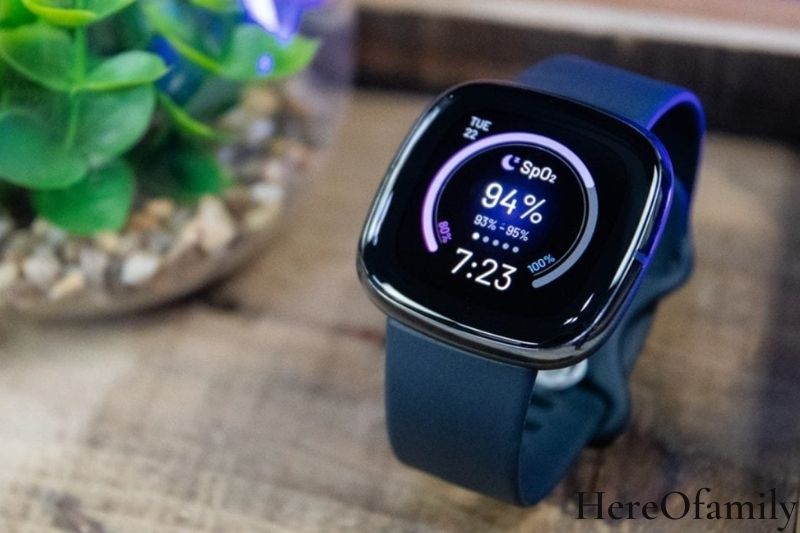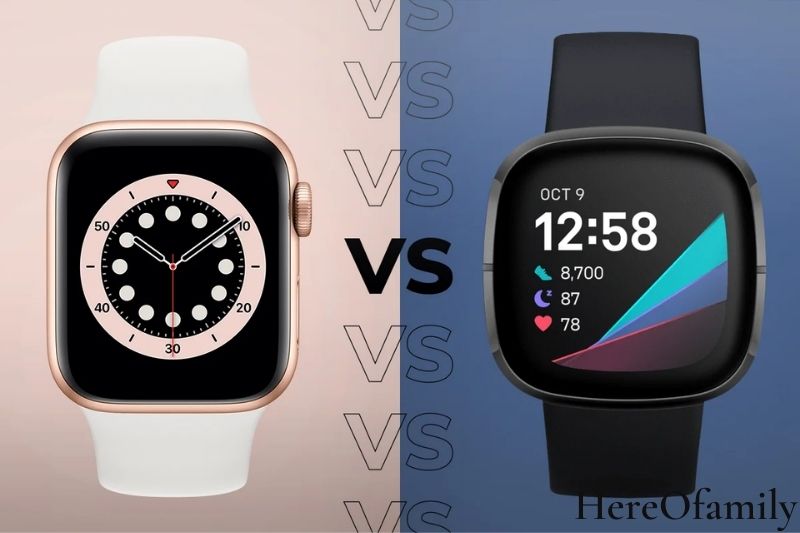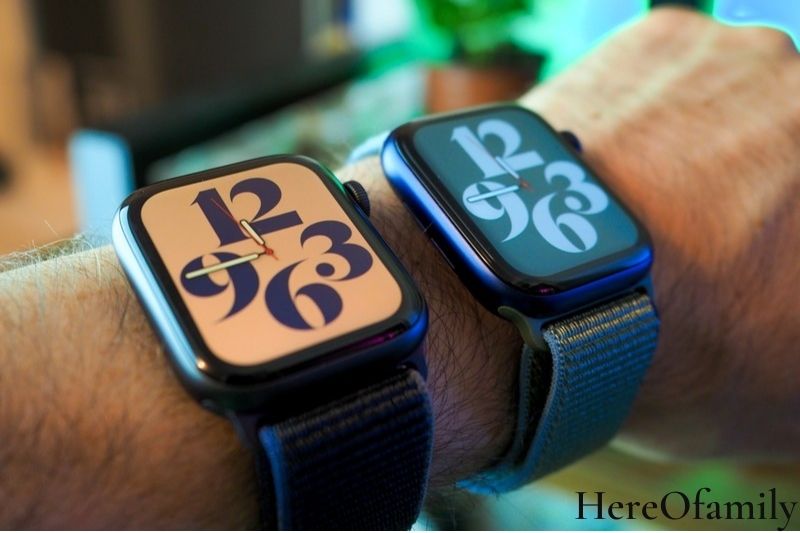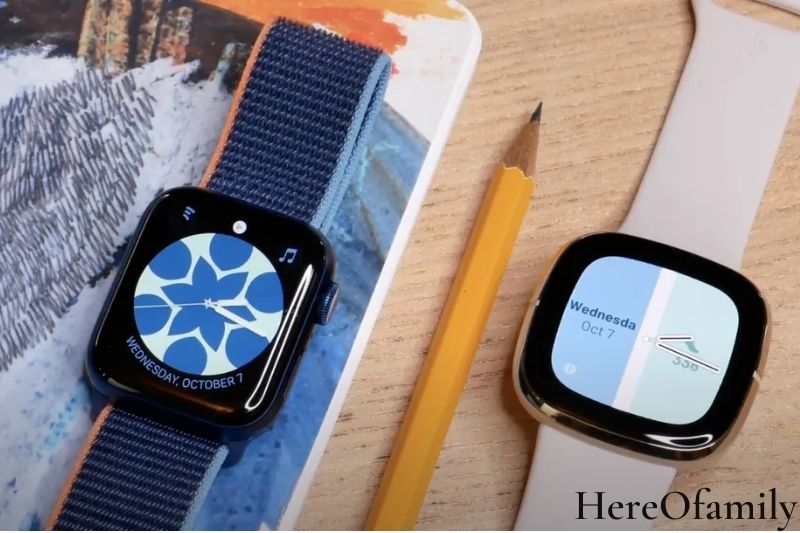The Fitbit Sense vs Apple Watch 6: They are is two of the most popular fitness trackers. They both have unique features that make them stand out from the competition. Here is a comparison of the two devices to help you decide which one is right for you.
Contents
- 1 Apple Watch Series 6
- 2 Fitbit Sense
- 3 1. They’re both comfy to wear and have familiar designs
- 4 2. Although Fitbit has added sensors, you may not require them
- 5 3. Great fitness trackers; however, the Apple Watch’s HR is more accurate
- 6 4. There are more smart features on the Apple Watch
- 7 FAQs
- 8 Conclusion
Apple Watch Series 6
The most refined smartwatch for all-around use
The new Apple Watch offers a lot of fitness tracking functions and an FDA-approved ECG, blood oxygen tracking, and all the responsiveness you could desire from a smartwatch. It’s also the better choice if you want to use your watch without your iPhone and need built-in LTE.
Pros
- Navigation at a higher level
- Pre-installed maps
- Keeping track of safety
- Built-in cellular capability is available as an option.
- Internal storage space
Cons
- Battery life is limited.
- There will be no quick charging.
- Only available on iOS.

Fitbit Sense
A good fitness watch for tracking sleep and battery life.
The Fitbit Sense also has an FDA-approved ECG, excellent sleep tracking, a temperature sensor, and a stress sensor. Like this Apple smartwatch, it works with Android, has a large selection of third-party watch faces, and has the most extended battery life of the two watches.
Pros
- ECG + EDA
- AZM + GPS built-in
- A score of Daily Readiness
- Rapid recharging
- Apple’s iOS and Google’s Android
Cons
- There isn’t a built-in cellular option.
- There is no safety monitoring.
- Storage is kept to a minimum.

1. They’re both comfy to wear and have familiar designs
The Series 6 includes a square face that comes in two sizes (40 and 44mm) and a digital crown and side button, just like every other Apple smartwatch before it.
The Sense has a stainless steel rim around the square face and looks like a higher-end Versa, but instead of a physical button, it has an indentation on the side that vibrates when hit and may be used to manipulate the screen.
Because of the bezels, the Fitbit is physically more significant than the 40mm Apple smartwatch, but the actual screen size is only a hair more extensive. It like the Sense, has bezels around the screen, though they’re thinner.
Each watch features a color, always-on screen that’s easy to view in bright sunlight, though I found that while glancing down at my wrist during an outdoor workout, the Apple Watch has the edge in terms of overall brightness.
The Sense features a more extensive selection of watch faces than the Apple smartwatch, including third-party options. However, some faces can be further customized to incorporate complexities, which are akin to shortcuts: At a glance, they can provide information like the weather or calendar appointments. Both are available in a variety of colors and hardware finishes.
Both include quick-release straps that can be swapped in and out, and you can vary up the style with a choice of bands, including leather, woven, and silicone options.
Still don’t know how to change the face of a smartwatch, see this guide to change the face the Apple Watch.
2. Although Fitbit has added sensors, you may not require them
With their ECG apps, each watch can check for indicators of a heart ailment called atrial fibrillation or aFib. To take a reading on the Apple smartwatch, place your finger on the digital crown for 30 seconds, while on the Fitbit Sense, place your index and thumb on the opposing corners for the same length of time.
You can tell your doctor about the results of both tests. See where the ECG is accessible on the Apple Watch and Fitbit Sense worldwide. Each watch may also detect indicators of an abnormally high or low heart rate and alert you.
These devices can monitor your SpO2, or blood oxygen saturation, while you sleep. For the Apple smartwatch, check levels in the Health app on your iPhone, or wait an hour after waking up for the Fitbit to calculate your nighttime average on the SpO2 watch-face. It’s also visible in the Fitbit app’s sleep area, where it displays variances and your SpO2 average.

This Apple smartwatch can also check your SpO2 in real-time and take background readings throughout the day, whereas the Fitbit doesn’t offer an on-demand task.
These watches aren’t meant to be used as medical instruments, and they might not be as accurate as a typical pulse oximeter, which doctors use to measure SpO2.
Fitbit’s watch contains two extra sensors that the Apple Watch lacks: a temperature sensor that tracks changes in skin temperature during the night and an EDA, or electrodermal activity sensor, which evaluates stress levels through sweat.
Differences in baseline temperature (as measured by the Sense) might signal a variety of diseases, such as the onset of a fever or a shift in the menstrual cycle.
But, as fascinating as all of this information is, stress detection in the Sense, in particular, appears to be more of a work in progress than a fully-fledged health feature at the moment. To get a reading, place your palm on the watch face for two minutes while the EDA sensor evaluates your sweat levels.
The watch then calculates a stress score based on this metric and sleep exercise and heart rate variability data to explain how your body reacts to stress. The difficulty is that Sense doesn’t tell you what to do if your stress management score is high or low, such as getting more sleep or delaying a strenuous activity. The Fitbit app has some guided meditations, but I’m not sure how successful they lowered my stress levels.
You’ll need to pay $10 a month for a Fitbit Premium membership to access these guided meditations and guided workouts, more complex health data, sleep, and temperature differences. Apple recently launched its $10-per-month Fitness Plus program, which includes workout courses that can be projected on your iPhone, iPad, or Apple TV and synced to your Apple Watch.
Both devices have built-in sleep tracking, but the Fitbit Sense has more information than the smartwatch of Apple. Premium customers can see a breakdown of their sleep stages, such as deep, REM, and light sleep, and their breathing rate, SpO2, and temperature fluctuations, all of which contribute to a sleep score in the morning.
The smartwatch of Apple is more concerned with maintaining a healthy bedtime pattern, and it concentrates on sleep length, which includes intervals of waking time throughout the night and heart rate and SpO2 data.
If you remain immobile after a violent fall, the Apple Watch contains a fall detection feature that can summon emergency services and contacts. Noise level alarms, irregular heart rate alerts, VO2 max readings, and movement metrics are included. It’s also the only one with Family Setup that you can potentially give to children or elderly relatives to keep track of their daily health data.
3. Great fitness trackers; however, the Apple Watch’s HR is more accurate
In addition to standard metrics like steps and calories, each watch can track various specialized exercises. There are almost 40 distinct workouts available on the Apple smartwatch, whereas Fitbit has over 20 that cover all effective alternatives. Both watches detect specific activities, such as walks and runs, so you get credit for your efforts even if you forget to start one manually. They’re also water-resistant so that they can keep track of swims.
Both have built-in GPS so you can follow the route of your outdoor workouts without carrying your phone with you, but the Sense takes about 10 seconds to get a signal outside, whereas the smartwatch of Apple takes only a second or two.
I ran a 4-kilometer outdoor run on both, and when I checked the Sense and Apple Watch findings on a map, the distance and route were nearly identical.

The Sense also displays real-time heart rate zones on the screen, such as cardio, fat burn, and peak. It can make a buzzing sound as you approach different heart rate zones, which can be helpful if you’re trying to train at a specific intensity.
When I compared the heart rate tracking on the Apple and Sense during an outdoor run to a chest strap, which is the industry standard for this type of measure during workouts, I saw that this smartwatch kept up, but the Sense often lagged by 20 to 30 beats per minute. The Sense caught up to the strap’s readings after about 10 to 15 minutes.
The watches break down your stats in the iPhone Fitness app (Apple Watch) or the Fitbit app after your workout (Sense). I like how the Fitbit app displays your workout statistics, including splits and heart rate zones, clearly and easily understandable. Instead of splitting it down into zones, the Apple smartwatch displays your range, splits, and heart rate on a graph.
4. There are more smart features on the Apple Watch
The Apple smartwatch is the better package if you want a dedicated smartwatch. While the Fitbit focuses on health tracking, it is the better package if you also want a dedicated smartwatch. More third-party apps, more robust connectivity with the iPhone, and overall speedier performance.
Even simple operations like changing watch faces or syncing applications can take up to 30 seconds on the Fitbit Sense, but it’s nearly instantaneous on the smartwatch of Apple. On this smartwatch, responding to notifications or text messages is simple: dictate, send a preset response, or scribble on the keypad.
Because the mic and speaker are decent quality, you can even take calls from your wrist. If you have an iPhone, you won’t be able to respond to notifications with the Sense, but if you have an Android phone, you can either send a brief response or dictate a message.
However, because Sense contains a speaker and microphone, iPhone and Android users can answer calls from their wrist as long as the watch is within range of the phone.

The Apple Watch is the only one with an LTE option, which costs $100 more than the Wi-Fi-only model (it costs $499 in the US) and allows you to make calls and stay connected without having to keep your phone nearby.
Each device can use a speech assistant: Siri on the Apple Watch or Alexa, or Google Assistant on the Sense. Siri can do various tasks, including starting a workout, sending a text message, and setting a timer. Sense’s Google Assistant is far more powerful than Alexa, allowing you to create a workout or check your sleep data, but you won’t be able to send a message.
Alexa is slower, but it can operate smart home devices if you have them, and the Assistant can start a Routine. With Siri on the Apple smartwatch, you can control smart home gadgets.
Finally, Fitbit Sense does not allow you to save your music. Instead, with a premium subscription, you can only download music from Deezer or Pandora for offline listening. The Apple smartwatch, on the other hand, allows you to store your music (it has 32GB of storage) or subscribe to Apple Music and download music for offline listening.
And if you want to buy a smartwatch for your children, this guide may be helpful: Apple Watch For Kids
5. The Fitbit Sense has a significant advantage in terms of battery life
I was able to get a day and change out of the 40mm Apple Watch Series 6 with alerts from your phone, sleep monitoring, and the always-on display engaged. You’ll need at least 30% battery life to track your sleep, so you’ll need to charge this watch every day unless you turn off the always-on display, which can extend the power life to almost two days.
With notifications, an always-on display, and sleep tracking, the Fitbit Sense lasts two days and may be extended to almost five days by turning off the always-on display.
A patented magnetic puck clamps onto the back of each watch to charge it. The Apple Device charger is backward and forwards compatible with previous Apple Watches.
However, the Fitbit Sense charger is created mainly for the watch (you won’t be able to use older Fitbit chargers like the Versa with the Sense, for example). Both devices charge to 100% in roughly an hour and a half.
FAQs
Is the Fitbit compatible with iOS?
Yes. Fitbit Sense is compatible with both Android and iOS devices.
Is the Apple Watch 6 compatible with Android?
No, the series 6 can only be used with an iPhone.

What does Fitbit offer that the Apple Watch lacks?
Fitbit continuously measures your heart rate 24 hours, seven days a week. During exercise tracking, they can retain heart rate data at 1-second intervals and 5-second intervals at all other times. This smartwatch on the other hand (or should I say wrist?), checks your heart rate every ten minutes during the day.
Is the Apple Watch or the Fitbit more accurate regarding steps?
Many people claim that Fitbit is more accurate at counting steps. It’s more trustworthy and user-friendly because you can see them while walking. Of course, the smartwatch is still valid, especially once calibrated.
Conclusion
The Fitbit Sense is a great fitness tracker for the casual user. It tracks a ton of data and is accurate, but it’s not very aesthetically pleasing.
If you are looking for a stylish and wearable fitness tracker that doesn’t require charging, you should get the Apple Watch. HereOfamily hopes you found this article helpful. If you have any questions, please leave a comment below.